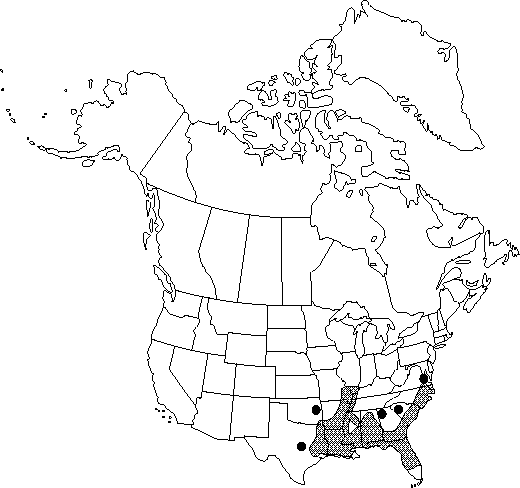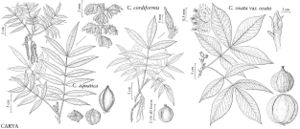Difference between revisions of "Carya aquatica"
Gen. N. Amer. Pl. 2: 222. 1818.
FNA>Volume Importer |
FNA>Volume Importer |
||
| Line 30: | Line 30: | ||
}}<!-- | }}<!-- | ||
| − | --><span class="statement" id="st- | + | --><span class="statement" id="st-undefined" data-properties=""><b>Trees,</b> to 46 m. <b>Bark</b> light gray or brownish, exfoliating, separating freely into long strips or broad plates, less commonly with small platelike scales. <b>Twigs</b> brown to reddish brown or black, slender, villous becoming glabrous. <b>Terminal</b> buds brown, reddish brown, or black, oblong, 8-10 mm, yellow-scaly, villous; bud scales valvate; axillary buds protected by bracteoles fused into hood. <b>Leaves</b> 4-6 dm; petiole 3-8 cm, villous becoming glabrous. <b>Leaflets</b> (5-)9-11(-13), lateral petiolules 0-2 mm, terminal petiolules (2-)6-10(-14) mm; blades ovate-lanceolate, often falcate, 2-19 × 1-4 cm, margins finely or coarsely serrate to entire and wavy, without tufts of hairs, apex acuminate; surfaces abaxially villous with unicellular and 2-8-rayed fasciculate hairs along midrib and secondary veins, densely scaly in spring with large peltate scales and small round, irregular, and 4-lobed peltate scales, adaxially villous along midrib near base, glabrous between veins. <b>Staminate</b> catkins pedunculate, to 21 cm, stalks villous, bracts scaly; anthers without hairs. <b>Fruits</b> brown, bronze, or black, obovoid, compressed, 1.5-3 × 1.5-2.5 cm; husks rough, 1 mm thick, dehiscing to base or nearly so, sutures winged; nuts chocolate brown, broadly obovoid, compressed, 2-angled, verrucose; shells thin. <b>Seeds</b> bitter. <b>2n</b> = 32.</span><!-- |
-->{{Treatment/Body | -->{{Treatment/Body | ||
| Line 61: | Line 61: | ||
|publication year=1818 | |publication year=1818 | ||
|special status=Endemic;Selected by author to be illustrated | |special status=Endemic;Selected by author to be illustrated | ||
| − | |source xml=https://jpend@bitbucket.org/aafc-mbb/fna- | + | |source xml=https://jpend@bitbucket.org/aafc-mbb/fna-data-curation.git/src/9216fc802291cd3df363fd52122300479582ede7/coarse_grained_fna_xml/V3/V3_724.xml |
|genus=Carya | |genus=Carya | ||
|species=Carya aquatica | |species=Carya aquatica | ||
| − | |||
| − | |||
| − | |||
| − | |||
| − | |||
| − | |||
| − | |||
| − | |||
| − | |||
| − | |||
| − | |||
| − | |||
| − | |||
| − | |||
| − | |||
| − | |||
| − | |||
| − | |||
| − | |||
| − | |||
| − | |||
| − | |||
| − | |||
| − | |||
| − | |||
| − | |||
| − | |||
| − | |||
| − | |||
| − | |||
| − | |||
| − | |||
| − | |||
| − | |||
| − | |||
| − | |||
| − | |||
| − | |||
| − | |||
| − | |||
| − | |||
| − | |||
| − | |||
| − | |||
| − | |||
| − | |||
| − | |||
| − | |||
| − | |||
| − | |||
| − | |||
| − | |||
| − | |||
| − | |||
}}<!-- | }}<!-- | ||
-->[[Category:Treatment]][[Category:Carya]] | -->[[Category:Treatment]][[Category:Carya]] | ||
Revision as of 13:48, 27 July 2019
Trees, to 46 m. Bark light gray or brownish, exfoliating, separating freely into long strips or broad plates, less commonly with small platelike scales. Twigs brown to reddish brown or black, slender, villous becoming glabrous. Terminal buds brown, reddish brown, or black, oblong, 8-10 mm, yellow-scaly, villous; bud scales valvate; axillary buds protected by bracteoles fused into hood. Leaves 4-6 dm; petiole 3-8 cm, villous becoming glabrous. Leaflets (5-)9-11(-13), lateral petiolules 0-2 mm, terminal petiolules (2-)6-10(-14) mm; blades ovate-lanceolate, often falcate, 2-19 × 1-4 cm, margins finely or coarsely serrate to entire and wavy, without tufts of hairs, apex acuminate; surfaces abaxially villous with unicellular and 2-8-rayed fasciculate hairs along midrib and secondary veins, densely scaly in spring with large peltate scales and small round, irregular, and 4-lobed peltate scales, adaxially villous along midrib near base, glabrous between veins. Staminate catkins pedunculate, to 21 cm, stalks villous, bracts scaly; anthers without hairs. Fruits brown, bronze, or black, obovoid, compressed, 1.5-3 × 1.5-2.5 cm; husks rough, 1 mm thick, dehiscing to base or nearly so, sutures winged; nuts chocolate brown, broadly obovoid, compressed, 2-angled, verrucose; shells thin. Seeds bitter. 2n = 32.
Phenology: Flowering spring.
Habitat: Bayous, river flood plains, bluffs, and levees, temporarily flooded bottomlands
Elevation: 0-200 m
Distribution

Ala., Ark., Fla., Ga., Ill., Ky., La., Miss., Mo., N.C., Okla., S.C., Tenn., Tex., Va.
Discussion
Carya aquatica hybridizes with C. illinoinensis (C. ×lecontei Little [= Hicoria texana Le Conte]) and is reported to hybridize with the tetraploid C. texana [C. ×ludoviciana (Ashe) Little].
Selected References
None.
